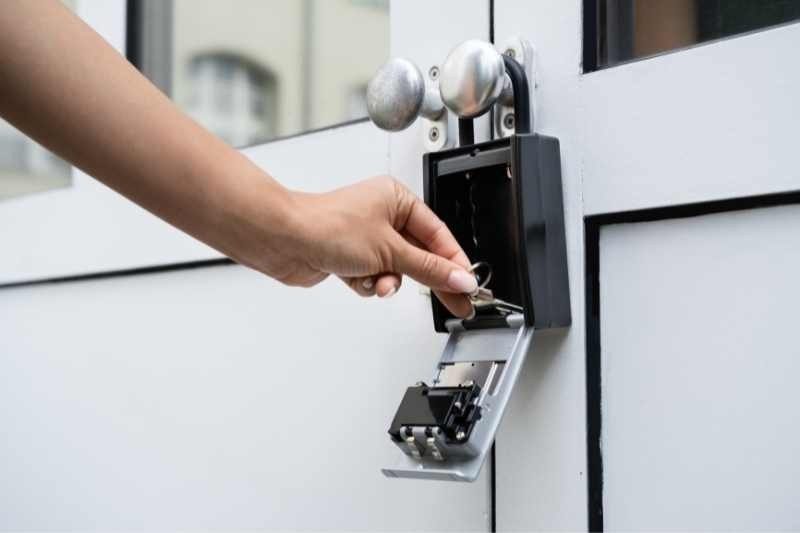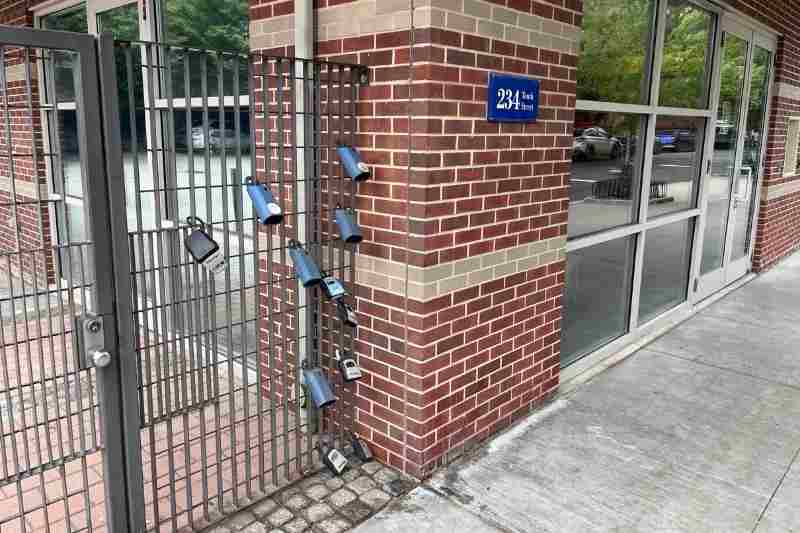Key takeaways
- Key lock boxes are convenient, but their convenience may come at the cost of your property’s security.
- Key safe lock boxes are easy to destroy, too exposed to the outdoors, and their passwords are too insecure.
- Instead of a key lock box, integrate your access control system with smart locks for more convenience and more features.

Are you interested in letting prospective tenants take self-guided tours? Or, you might just want to make it easier for prospects to drop off and pick up keys. Whatever the case, property managers once depended on key lock boxes to give prospects easy access to the keys they’d need to tour a building. But are they the best way to store and manage keys at your property?
In this post, we go over what a key lock box is and how it works. Then, we explain why realtors use lockboxes, list their limitations, and offer an alternative.
This post covers:
- What is a key lock box?
- Why do realtors use lockboxes?
- 5 best key lock boxes
- Limitations of key lock boxes
- Best alternative to a key lock box
What is a key lock box?
A key lock box is a box used to safely and securely store a key. Key lock boxes are usually secured by a combination lock that requires users to enter a code or PIN number to unlock the box. Residents or staff share the combination with approved visitors so they can retrieve the key from the lock box.
However, some lock boxes have a traditional tumbler lock and key, which requires someone to have a key just to retrieve another key!
Key lock boxes are staples at properties of all shapes and sizes, from single-family homes to high-rise residential and commercial properties with hundreds of units. This is because lock boxes for keys are cheap and fairly intuitive to use.
An apartment resident might give the lock box code to a repairperson who will be stopping by while they’re at work, or a friend who’s pet sitting. And as you might imagine, property managers, leasing agents, and realtors also frequently use key boxes.
For property managers and realtors, a lockbox simplifies the process of dropping off and picking up keys from prospective tenants and allows the option of self-guided touring.

Why do realtors use lockboxes?
Realtors use lockboxes to simplify key management. Lock boxes allow realtors to show properties faster and with less hassle by providing a way to get keys in prospects’ hands without going on-site to meet them.
Self-guided touring has taken off in recent years. Property managers who want to include a self-guided touring option use key box locks to let prospects take tours without an agent present.
Here’s how to use a lockbox for a self-guided tour:
- Give lock box credential to prospect. For a key lock box with a code, this might be a PIN number, or it might be a physical key. If it’s a smart key lock box, management must give prospects a single-use code or have them download a specific mobile app.
- Prospect takes tour. Thanks to the lock box, prospects can retrieve a key to unlock the vacant unit — without needing a realtor to be physically present.
- Prospect returns key to lock box. The prospect uses their credential to open the lockbox up again. If your lock box uses a key, the prospect must return that key to a property staff member.
Watch how ButterflyMX enables self-guided tours:
Where do you mount a key lock box?
Typically, you mount a key lock box in a place that’s out of the way and hidden, but easily accessible. For example, you might mount a key lock box behind some outside greenery or at a low height to make sure it isn’t easily seen.
You can increase the security of your key lock box by putting it in a place on your property that has already screened its visitors. For example, if you have a gated property, you can place a wall-mounted lock box in this gated area.
This way, visitors can take a key before they enter the building — but you can still maintain property security because the box is out of the way of the general public outside of the gate.
Are lock boxes easy to break into?
Unfortunately, lock boxes are easy to break into.
Even if a lock box has a complex locking mechanism, like a combination lock or an electronic keypad, lock boxes are typically very small and their walls are made of thin materials. A determined intruder could simply break many lock boxes open.
5 best key lock boxes
If you want to use key safes at your property, you’re probably wondering which ones to buy.
5 of the best key lock boxes include:
- MasterLock 5400D Portable Lock Box
- Kidde AccessPoint KeySafe
- Kingsley Guard Key Lock Box
- Pangaea Key Hider Fake Rock
- WordLock Key Lock Box
1. MasterLock 5400d Portable Box Lock
The weather-resistant Portable Box Lock is the perfect key lock box for outside. This lock hangs right over a doorknob so that visitors will never have trouble finding it. You also have the option to personalize your Portable Box Lock with laser engraving.
Read the full MasterLock 5400D review »
2. Kidde AccessPoint KeySafe
The Kidde Access Point has multiple features designed to deter intruders and thieves, including sloped sides that discourage crowbars. It’s also the rare key lock box that features a combination dial, instead of more common key-based or wheel combination lockboxes.
Read the full Kidde AccessPoint KeySafe review »
3. Kingsley Guard-a-Key Lock Box
Kingsley lock boxes come with many features that make their lock box as unobtrusive and efficient as possible. The Guard-a-Key comes with a vinyl coating that stops it from scratching surfaces, and it’s big enough to store multiple keys.
Read the full Kingsley Guard-a-Key Lock Box review »
4. Pangaea Key Hider Fake Rock
Some property managers might go for an approach that depends on concealing a key and leaving instructions for it instead of a traditional lock box. While this approach has its pros and cons, fake, hollow rocks that have spaces for keys like the Pangaea Key Hider are one of the more popular options.
Read the full Pangaea review »
5. WordLock Key Lock Box
The WordLock Key Lock Box is another unorthodox way to give a credential to a visitor. Instead of a PIN number, you can give a visitor a four-letter combination — which will improve the chances that your visitor remembers your lock box password.
Read the full WordLock key lock box review »

Use cases for key lock boxes
If you’re wondering why you might use a key lock box, property managers use them to make many aspects of running a property easier.
You might use a key lock box to:
- Make key management easier. By providing one place where all of the keys on your property can be stored, you reduce the chances of a resident or staff member losing a key.
- Simplify access for service providers. Sometimes, individual residents will want service providers like house cleaners or dog walkers to have access to their units. On a building-wide level, repair people may need access to critical plumbing or utility areas. Either way, you’ll need to keep track of who has which key.
- Enable self-guided touring. If you leave the keys to a unit that you’d like to rent out in a lockbox, prospects can pick up the key and tour the unit themselves without you having to be there. This puts less pressure on a resident and allows you to spend your time elsewhere.
Limitations of key lock boxes
Even though some modern lockboxes for keys are helping property managers out with innovations like Bluetooth and WiFi-enabled unlocking, they still can’t keep up with the times. Here are some things you should know before you invest in a key lock box.
Problems with key lock boxes include:
1. Easy to destroy
Are lock boxes easy to break into? Unfortunately, the answer is yes.
Many lock boxes depend on a wheel combination lock, in which a user chooses the digit they’re putting into the lock by rotating the edge of a “wheel” containing every single-digit number. When you have four or six of these wheels in a row, a user can input a longer, more secure PIN number.
However, you can easily look up videos that show you how to bypass all kinds of locks with just PINs. Additionally, lock boxes aren’t particularly strong or durable, so someone could tamper with or destroy the box’s casing entirely.
2. Exposed to outdoor elements
It’s true that leaving a key lock box outside makes access to the key easy. However, you don’t want to make it too easy.
A wall-mounted key lock box in an obvious place is an easy target. Some property managers try to secure their lock boxes and hide a key lock box in an out-of-the-way place, like under a rock or under a shrub or bush. While this is the correct instinct, you always run the risk of a visitor missing the lock box’s location.
And even if a visitor does track down a key, that’s not always the whole story. What if a client is looking for an outdoor key safe during intense summer heat or a rainstorm? A lot of things can go wrong — and put a visitor in a bad mood — when you’re depending on the weather to play nice.

3. People might share the password
Key storage boxes that require combination numbers to unlock are subject to this glaring weakness. While you might instruct a resident or visitor not to share the key box combination with others, you might be dealing with dozens, or even hundreds, of visitors every week — especially if you use lock boxes for self-guided tours. How can you be sure that all of them will listen to you?
Are you prepared to change the combination on the lock yourself — or, worst case, spend money hiring a locksmith — every time a visitor returns a key? Unfortunately, that might be the only way you can maintain your property’s security if you depend on a key lock box.
Best alternative to a key lock box
Say farewell to traditional metal keys and embrace the convenience of smart locks that integrate effortlessly with a powerful access control system like ButterflyMX.
Trusted by over 15,000 properties and backed by 20,000+ reviews, ButterflyMX is a cloud-based solution that simplifies access control. Our system works seamlessly with smart locks, letting you replace outdated keys with secure, mobile-based entry.
With ButterflyMX, everyone from staff to residents, visitors, and service providers can use their smartphones to access the property. Our platform provides complete control, covering everything from the front doors and gates to elevators, amenities, and even individual units.
Forget about managing bulky key rings. ButterflyMX offers an easy-to-use system through a mobile app or online dashboard, allowing you to monitor access logs, manage user permissions, and integrate smart locks for a streamlined, hassle-free experience.






